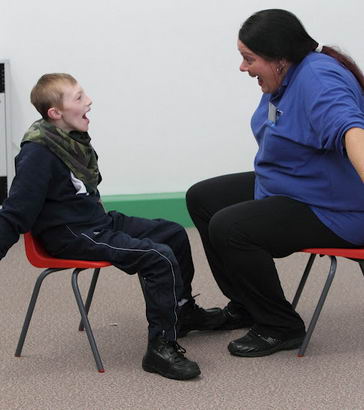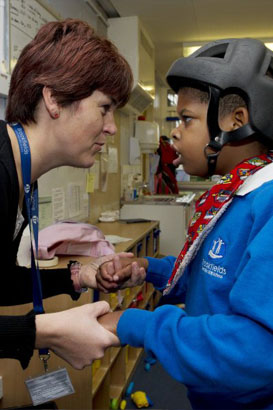
Process based learning (Collis and Lacey, 1996; Hewett and Nind, 1998; Nind and Hewett, 2001; Hewett, 2006; Imray et al, 2010) is a holistic approach where the process of teaching becomes the objective.
The entire process of learning is taken as a whole, as opposed to teaching to specific individualised targets. Intensive Interaction (Nind and Hewett, 1994) is perhaps the best example of process based learning (and teaching). In this example, it is not the outcome of the task that is important, but the interactive process that drives the task that is the focus – this is termed 'tasklessness'.
Interactors need to:
- Follow, celebrate and extend;
- 'Tune in' to the learner and look for communication moments; and
- Create a communicative flow that is ultimately the objective of the session.
The teacher may prompt and try different strategies to elicit progress, and the most skilful and experienced teachers will have many strategies for achieving this. However, it is up to the learner, not the teacher, to decide specific targets.
The learner decides:
- Where the interactive process will go;
- The pace and direction of learning; and
- The pace and direction of teaching.

Process based teaching provides a platform for varied and disparate learning to take place. However, a child's individual
progression may only be recognised in retrospect, at the end of each session, week, half-term, term and/or year
(Imray et al, 2010).
This retrospective target setting is legitimated because objective based teaching tends to narrow the learning opportunities offered to those with SLD/PMLD/CLDD.
In contrast, processed based learning does not narrow learning opportunities but helps to identify the best objectives for each child by looking at the process of learning.
A child at early developmental levels has much more chance of understanding and connecting the process, sequence, and materials needed to wipe a runny nose if the learning takes place when she has a runny nose.
The child with SLD/PMLD/CLDD has much more chance of understanding and connecting the process and sequence of a story when a story is actually being enacted, and the learner is an essential part of that enactment (Park, 2010; Grove, 2010).
All sorts of learning may take place here:
- Sequencing
- Memory of events
- Anticipation
- Tracking
- Object permanence
- Emotional experience and understanding
- Contingency responding
- Contingency awareness
- Peer and adult interaction
- Sensory exploration
- Sensory tolerance, etc.
To get the best results, limit the recording of progress to one or two previously defined SMART targets. At best, this will produce limited opportunities to expand learning.

In contrast, whatever the circumstances, target driven teaching is likely to lead teachers to teach to the next level (as defined by various assessment documents, particularly those that break the p-scales down into very small steps).
This might be completely inappropriate because:
- It might not suit the individual pupil: and
- The target might not be suitable or of interest to a particular child.
Furthermore, the long term effect can be damaging. Targets might not be achieved:
- Because the pupil is not motivated to achieve them; or
- Because the target is too cognitively or physically challenging for the pupil to achieve, the target will either be dropped or linger on in a diluted and meaningless form.
It is important to note that the consideration and development of child directed learning is reflected in the Independent Review of the Primary Curriculum: Final Report (Rose, 2009) on primary curriculum development.
To what extent does the planning in your school accommodate the principles of a process-based approach?

Collis, M. and Lacey, P. (1996) Interactive Approaches to Teaching, London: David Fulton.
Grove, N. (2010) The Big Book of Storysharing, London: Senjit.
Hewett, D. and Nind, M. (eds) (1998) Interaction in Action: Reflections on the Use of Intensive Interaction, London: David Fulton.
Nind, M. and Hewett, D. (1994)Access to Communication: Developing the basics of communication with people with severe learning difficulties through Intensive Interaction, London: David Fulton.
Nind, M. and Hewett, D. (2001) A Practical Guide to Intensive Interaction, Kidderminster: British Institute of Learning Disabilities.

Imray, P., Gazquez Navarro, D. and Bond, L. (2010) A PMLD Curriculum for the 21st Century, The SLD Experience, issue 58.
Park, K. (2010) Interactive storytelling: developing inclusive stories for children and adults, London: Speechmark.
QCDA (2009) Using the P Scales, London: Qualifications and Curriculum Authority.
QCDA (2009) Planning, teaching and assessing the curriculum for pupils with learning difficulties. General guidance, London: Qualifications and Curriculum Authority.
Rose, J. (2009) Independent Review of the Primary Curriculum: Final Report, Nottingham: DCSF publications.